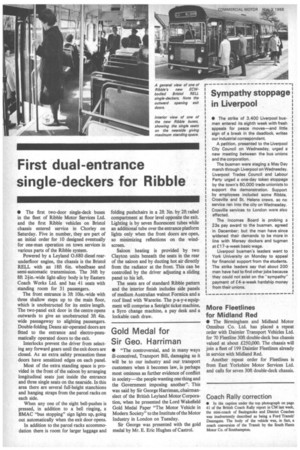First dual-entrance single-deckers for Ribble
Page 60

If you've noticed an error in this article please click here to report it so we can fix it.
• The first two-door single-deck buses in the fleet of Ribble Motor Services Ltd. and the first Ribble vehicles on Bristol chassis entered service in Chorley on Saturday. Five in number, they are part of an initial order for 10 designed eventually for one-man operation on town services in various parts of the Ribble system.
Powered by a Leyland 0.680 diesel rearunderfloor engine, the chassis is the Bristol RELL with an 18ft 6M. wheelbase and semi-automatic transmission. The 36ft by 8ft 24in.-wide light-alloy body is by Eastern Coach Works Ltd. and has 41 seats with standing room for 31 passengers.
The front entrance is 3ft 10in.-wide with three shallow steps up to the main floor, which is unobstructed for its entire length.
The two-panel exit door in the centre opens outwards to give an unobstructed 3ft 4in.
wide passageway to alighting passengers. Double-folding Deans air-operated doors are fitted to the entrance and electro-pneumatically operated doors to the exit.
Interlocks prevent the driver from selecting any forward gears until the exit doors are closed. As an extra safety precaution these doors have sensitized edges on each panel. Most of the extra standing space is provided in the front of the saloon by arranging longitudinal seats just inside the entrance and three single seats on the nearside. In this area there are several full-height stanchions and hanging straps from the parcel racks on each side.
When any one of the eight bell-pushes is pressed, in addition to a bell ringing, a BMAC "bus stopping" sign lights up, going out automatically when the exit door opens. In addition to the parcel racks accommodation there is room for larger luggage and folding pushchairs in a 2ft 3in. by 2ft railed compartment at floor level opposite the exit. Lighting is by seven fluorescent tubes while an additional tube over the entrance platform lights only when the front doors are open, so minimizing reflections on the windscreen.
Saloon heating is provided by two Clayton units beneath the seats in the rear of the saloon and by ducting hot air directly from the radiator at the front. This can be controlled by the driver adjusting a sliding panel to his left.
The seats are of standard Ribble pattern and the interior finish includes side panels of medium Australian walnut Formica and a roof lined with Warerite. The p-a-y-e equipment will comprise a Setright ticket machine, a Syro change machine, a pay desk and a lockable cash draw.




































































































































































































































